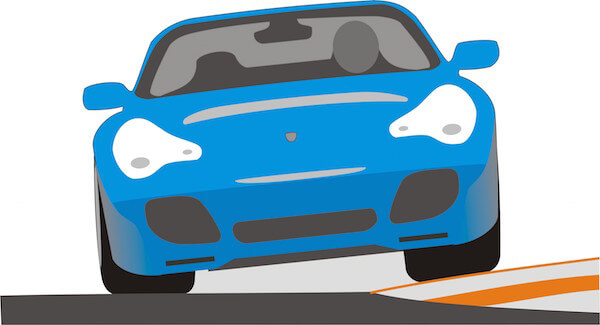Performance & Race Driving Tip
Speed Secret: The key to driving faster is managing your car’s weight.
You’re a weight manager.
 No, I’m not trying to convince you to follow a new diet. Nor am I going to tell you how to lighten your race car. What I’m talking about is how to manage the weight transfer while driving.
No, I’m not trying to convince you to follow a new diet. Nor am I going to tell you how to lighten your race car. What I’m talking about is how to manage the weight transfer while driving.
When your car is at a constant speed, its weight is equally distributed over all four tires. Well, let’s pretend it is, anyway. In reality, it’s distributed over the fours tires as it is when sitting still – some cars have more weight over the front tires (almost always front-wheel-drive cars do, but others do as well), and some have more over the rear tires. And due to the position of the driver and other heavy components, the weight may not even be equally distributed side to side. Hopefully, you’ve had your car “corner balanced,” so its suspension is adjusted to equalize the weight side-to-side as close as possible.
For our purposes here, let’s say your car is perfectly balanced when it’s sitting still, or when it’s being driven at a constant speed. If you had a way to measure the grip or traction that each tire had when it’s perfectly balanced, you’d see that your car has its maximum grip at that point. Whenever there is any weight transfer from braking, cornering or acceleration, and the car becomes less-than-perfectly balanced, it loses traction. Huh? “Why?” you ask.
As weight transfers onto a tire, it gains traction – push down harder on it and it grips the track surface more. When weight is transferred off of a tire, it loses grip. But here’s the thing: the tire that gains grip doesn’t gain as much as the tire that loses grip loses. Got it? Explained differently, you lose more traction from unweighting a tire than you gain by adding that same amount of weight to another tire.
So, whenever weight transfer occurs, (which is any time you brake, corner or accelerate), you have less overall traction than when the car was perfectly balanced. That may not seem fair – that just when you need it most, during cornering, for example, you actually have less traction than when you’re driving down a straightway – but it’s a fact of life. That’s physics for you.
The moral of the story is that your job, as a driver, is to manage your car’s weight transfer. Your goal is to cause as little weight transfer as possible. How? By being as smooth as you can be with the controls.
Oh, but there are times when you want to put more load on a particular end or corner of the car to help you get the car through a turn faster. But that’s a story for another day. For now, consider yourself a “weight manager.”
Check back here often for more tips and advice for performance drivers, race drivers, high performance driving instructors, and anyone else interested in learning to get around race tracks quickly.
Please do me favor and share this now with others who you think would either learn something from it, or enjoy it, by clicking on any of the links below. Thank you!
